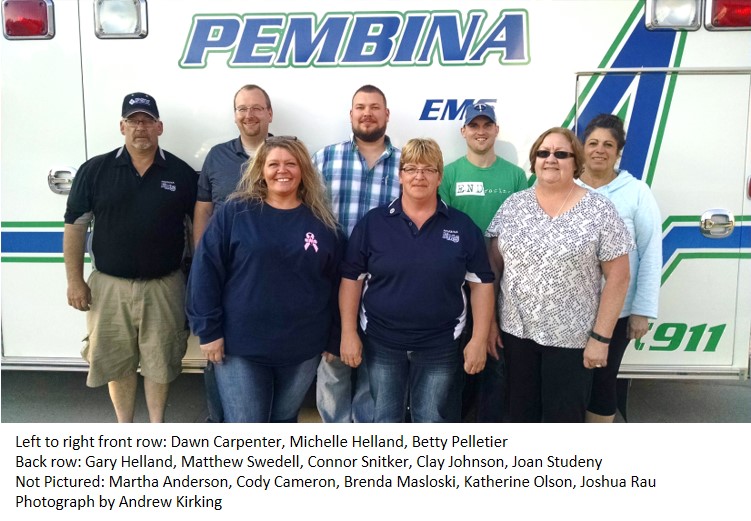Pembina County, ND - County News
County News
Pembina Ambulance: Learn How This Small Service Has Survived

By Liz Beck
Pembina County 911 Coordinator
Pembina Ambulance Service has a dedicated group of people who have persisted to keep the service available for the people in town, in spite of many obstacles. With determination, they have fought hard to maintain their licensure, especially in the last 10 years. But according to Michelle Helland, “if it wasn’t for the North Dakota EMS grant, there’s no way our service would still be up and running.”
These are tough words to acknowledge, but the trend is clear. Volunteers have always been the backbone of the state’s rural ambulances, for around 40 years. But that model, used across the nation, is not sustainable either near-term or far-term. Betty Pelletier has been with Pembina Ambulance Service for 36 years. She said “We used to have a lot of volunteers in town because employers would let them go on call, in order to help. But when that stopped, it really cut down our crew, to seven people at one time. We just kept plugging along.” There has also been an increased employment of volunteers beyond their home area, which has resulted in a loss of volunteers.
In 2010, the ND Division of Emergency Medical Services (EMS) and Trauma recognized the trend, and sought legislative dollars to assist many struggling ambulance services. Initially it came in the form of staffing grants, to hire new staff and offset the volunteers personal cost of training, travel, and ‘on call’ time. Michelle said, “Pembina Ambulance pays $12.00 an hour to pay it’s out of town members, as there are not enough local volunteers that are able to help.” It’s not enough to make a living, with the small number of hours, but it helps, considering the time these folks have to be away from home. “Local members receive $2.00 an hour when they’re on call, and they’re required to take 24 hours of call a month, non-consecutive,” said Michelle.
In 2012, the ND EMS Rural Assistance Grant expanded to allow supplies, building rent and utilities, cell phones for use in an ambulance, equipment, building improvements, and fuel. Michelle said, “The EMS grant dollars in 2015 went towards the bare minimum to keep our service rolling, for payroll, medical supplies and fuel.” This funding equates to 45% of the ambulance service’s 2015 annual budget.
Four members went through Emergency Medical Technician (EMT) training over the winter, and graduated April 2nd this year. They are Dawn Carpenter, Michelle Helland, Connor Snitker and Joan Studeny. The EMT course is 150 hours of training, and takes approximately six months to complete. Locally, classes consist of lectures every Wednesday night, and hands on training one or two Saturdays a month. Classes generally begin in the fall and end in the spring. “We ate a lot of M&Ms on Wednesday nights….we had a lot of candy,” Michelle said. They were able to take the training at the EMS Education Training Institute in Cavalier, instead of having to travel to Grand Forks. “Jan (Samson) does a great job of providing courses, and continuing education can also be taken there,” said Connor.
“Now that there are four EMTs, we need more drivers,” said Joan. Dawn added, “People can be a driver with an EVOC course (Emergency Vehicle Operators Course), and CPR/First Aid certification (Cardiopulmonary Resuscitation).” This amounts to less than eight hours. “It’s not necessary to go through the EMR (Emergency Medical Responder) class,” said Dawn, which is around 12 weeks, one night a week.
The EMS rural funding grants have an increased focus on services working together to realize shared goals. Legislative funding intent is to foster an EMS system in North Dakota, one that is sustainable. The transition of getting there could be a difficult road, and will require adjustments by most services in the state. While solutions are being formed, local Pembina community folks can help. Michelle said, “There are many levels on which people can help an ambulance service; it’s not all about taking classes, and being an EMT. We could get kids involved. If we have someone, even older people, that would babysit for a couple hours at a time……for certain members that have children. I’d be happy with a group of ladies to come up and do a fundraiser.” Joan added, “If they could help on the smallest level, anything would be great.”
If you would like to be a part of the effort to support the Pembina Ambulance Service, or have questions, please feel free to contact them at 701-825-6868. Volunteers will not be turned away.
